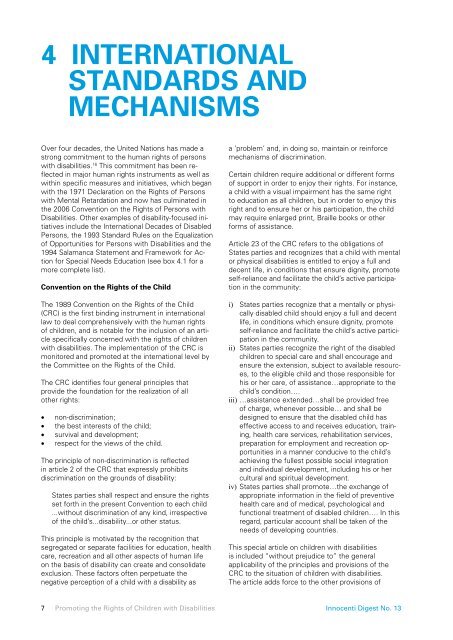Promoting the Rights of Children with Disabilities, UNICEF
Promoting the Rights of Children with Disabilities, UNICEF
Promoting the Rights of Children with Disabilities, UNICEF
- No tags were found...
You also want an ePaper? Increase the reach of your titles
YUMPU automatically turns print PDFs into web optimized ePapers that Google loves.
4 INTERNATIONALSTANDARDS ANDMECHANISMSOver four decades, <strong>the</strong> United Nations has made astrong commitment to <strong>the</strong> human rights <strong>of</strong> persons<strong>with</strong> disabilities. 16 This commitment has been reflectedin major human rights instruments as well as<strong>with</strong>in specific measures and initiatives, which began<strong>with</strong> <strong>the</strong> 1971 Declaration on <strong>the</strong> <strong>Rights</strong> <strong>of</strong> Persons<strong>with</strong> Mental Retardation and now has culminated in<strong>the</strong> 2006 Convention on <strong>the</strong> <strong>Rights</strong> <strong>of</strong> Persons <strong>with</strong><strong>Disabilities</strong>. O<strong>the</strong>r examples <strong>of</strong> disability-focused initiativesinclude <strong>the</strong> International Decades <strong>of</strong> DisabledPersons, <strong>the</strong> 1993 Standard Rules on <strong>the</strong> Equalization<strong>of</strong> Opportunities for Persons <strong>with</strong> <strong>Disabilities</strong> and <strong>the</strong>1994 Salamanca Statement and Framework for Actionfor Special Needs Education (see box 4.1 for amore complete list).Convention on <strong>the</strong> <strong>Rights</strong> <strong>of</strong> <strong>the</strong> ChildThe 1989 Convention on <strong>the</strong> <strong>Rights</strong> <strong>of</strong> <strong>the</strong> Child(CRC) is <strong>the</strong> first binding instrument in internationallaw to deal comprehensively <strong>with</strong> <strong>the</strong> human rights<strong>of</strong> children, and is notable for <strong>the</strong> inclusion <strong>of</strong> an articlespecifically concerned <strong>with</strong> <strong>the</strong> rights <strong>of</strong> children<strong>with</strong> disabilities. The implementation <strong>of</strong> <strong>the</strong> CRC ismonitored and promoted at <strong>the</strong> international level by<strong>the</strong> Committee on <strong>the</strong> <strong>Rights</strong> <strong>of</strong> <strong>the</strong> Child.The CRC identifies four general principles thatprovide <strong>the</strong> foundation for <strong>the</strong> realization <strong>of</strong> allo<strong>the</strong>r rights:• non-discrimination;• <strong>the</strong> best interests <strong>of</strong> <strong>the</strong> child;• survival and development;• respect for <strong>the</strong> views <strong>of</strong> <strong>the</strong> child.The principle <strong>of</strong> non-discrimination is reflectedin article 2 <strong>of</strong> <strong>the</strong> CRC that expressly prohibitsdiscrimination on <strong>the</strong> grounds <strong>of</strong> disability:States parties shall respect and ensure <strong>the</strong> rightsset forth in <strong>the</strong> present Convention to each child...<strong>with</strong>out discrimination <strong>of</strong> any kind, irrespective<strong>of</strong> <strong>the</strong> child’s...disability...or o<strong>the</strong>r status.This principle is motivated by <strong>the</strong> recognition thatsegregated or separate facilities for education, healthcare, recreation and all o<strong>the</strong>r aspects <strong>of</strong> human lifeon <strong>the</strong> basis <strong>of</strong> disability can create and consolidateexclusion. These factors <strong>of</strong>ten perpetuate <strong>the</strong>negative perception <strong>of</strong> a child <strong>with</strong> a disability asa ’problem’ and, in doing so, maintain or reinforcemechanisms <strong>of</strong> discrimination.Certain children require additional or different forms<strong>of</strong> support in order to enjoy <strong>the</strong>ir rights. For instance,a child <strong>with</strong> a visual impairment has <strong>the</strong> same rightto education as all children, but in order to enjoy thisright and to ensure her or his participation, <strong>the</strong> childmay require enlarged print, Braille books or o<strong>the</strong>rforms <strong>of</strong> assistance.Article 23 <strong>of</strong> <strong>the</strong> CRC refers to <strong>the</strong> obligations <strong>of</strong>States parties and recognizes that a child <strong>with</strong> mentalor physical disabilities is entitled to enjoy a full anddecent life, in conditions that ensure dignity, promoteself-reliance and facilitate <strong>the</strong> child’s active participationin <strong>the</strong> community:i) States parties recognize that a mentally or physi-cally disabled child should enjoy a full and decentlife, in conditions which ensure dignity, promoteself-reliance and facilitate <strong>the</strong> child’s active participationin <strong>the</strong> community.ii) States parties recognize <strong>the</strong> right <strong>of</strong> <strong>the</strong> disabledchildren to special care and shall encourage andensure <strong>the</strong> extension, subject to available resources,to <strong>the</strong> eligible child and those responsible forhis or her care, <strong>of</strong> assistance…appropriate to <strong>the</strong>child’s condition….iii) …assistance extended…shall be provided free<strong>of</strong> charge, whenever possible… and shall bedesigned to ensure that <strong>the</strong> disabled child haseffective access to and receives education, training,health care services, rehabilitation services,preparation for employment and recreation opportunitiesin a manner conducive to <strong>the</strong> child’sachieving <strong>the</strong> fullest possible social integrationand individual development, including his or hercultural and spiritual development.iv) States parties shall promote…<strong>the</strong> exchange <strong>of</strong>appropriate information in <strong>the</strong> field <strong>of</strong> preventivehealth care and <strong>of</strong> medical, psychological andfunctional treatment <strong>of</strong> disabled children…. In thisregard, particular account shall be taken <strong>of</strong> <strong>the</strong>needs <strong>of</strong> developing countries.This special article on children <strong>with</strong> disabilitiesis included “<strong>with</strong>out prejudice to” <strong>the</strong> generalapplicability <strong>of</strong> <strong>the</strong> principles and provisions <strong>of</strong> <strong>the</strong>CRC to <strong>the</strong> situation <strong>of</strong> children <strong>with</strong> disabilities.The article adds force to <strong>the</strong> o<strong>the</strong>r provisions <strong>of</strong>7 <strong>Promoting</strong> <strong>the</strong> <strong>Rights</strong> <strong>of</strong> <strong>Children</strong> <strong>with</strong> <strong>Disabilities</strong> Innocenti Digest No. 13
















